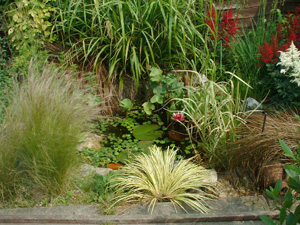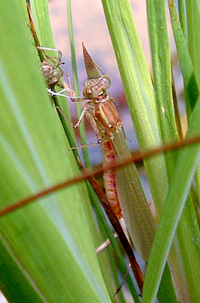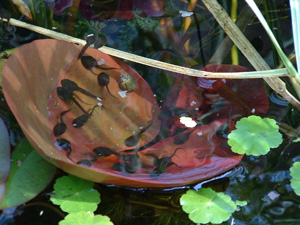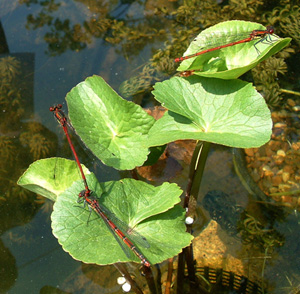Wildlife gardening - Frogs and other Pond Creatures
Making the garden friendly to frogs and other water creatures

Making a pond in your garden will attract a wide variety of wildlife to the garden. To start with, birds will come to drink and bathe during the day and at night you may be lucky enough to see a hedgehog coming to drink, though you may be more likely to hear it as hedgehogs are surprisingly noisy diners. Making a pond will help make your garden really wildlife friendly... and it does not need to be a big pond.
Make a pond
Making a pond isn't difficult and it doesn't have to be big. Our pond - on the right - is about the size of a six-person dining table and about 2.5 feet deep at the deepest level. It has one sloping side and a beach so that creatures can get in and out. The hole is lined with pond liner and the edges were done with rocks and stones. I'll be doing a proper guide to making a pond as soon as I can.
Once you have your pond built, and the plants put in, you donít need to do anything straight away apart from keeping it topped up with rain water in hot weather, although a bucket of muddy water from an established may help it to establish (ask for permission to take it first if itís a private pond).

Summer pond
If frogs and toads come to live in and around the pond, they will need shelter other than the water.
Plant plenty of leafy plants at the pond edge and place flat stones around the edge for them to shelter amongst. Leaving some bare soil at the pond edge will help birds too - many birds use mud for nest-making and will take it from the pond edges. In spring, you might see a blackbird collecting mud from around the edge of your pond.
Leaving some spaces under the stones will give amphibians somewhere to dig into when they need to rest and hibernate. Try not to disturb the water or pond edges from late autumn to spring so that any hibernating creatures are not woken or frightened away. If you need to clean or mend the pond, it is best to do it in early autumn.
Plants in the water itself will give shade and will also allow damselfly larvae to hatch - these need straight stems - reed-like plants, for example - to climb up where they can cling on and hatch out.

Newly hatched damselfly on a grass stem

Tadpoles
If you build it, they will come
You donít need to add any creatures yourself, they will find the water themselves and make their homes there. The first to arrive may be pond skaters, then beetles will fly in and damselflies will come to mate and lay eggs. In summer many flying insects will come to drink and will stand on leaves or at the water's edge.
On a night in spring you may hear frogs or toads croaking, followed by clumps of spawn in the water and then in a few weeks you'll go outside to see a pond teeming with tadpoles.
No fish = lots of wildlife
If you want the widest variety of wildlife to take up home in your pond, itís important that you do not put any fish in it as they will eat the eggs and tadpoles of frogs and toads and many other small creatures.
Surround the pond with plenty of plants so that creatures coming and going have somewhere safe to shelter.
Safety for all
Make sure that birds and other creatures have a way to get to the water safely - put large flat stones at the edge for them to stand on and ensure that one side of the pond is gently sloping, so that creatures which fall in can get out again.
If there are small children about, it might be better to make a small fence round the pond to keep them away from the water.

Damselflies mating over the pond
A note of caution
Frogs and toads both like to hibernate at the bottom of wood piles. If you are planning a fire for Bonfire Night, make sure you check right to the bottom of the heap before lighting it to save them from being trapped by the flames. Better still, store the wood in a different spot to where it will be burned. More here: Garden Journal November 5th 2007

© Copyright Miranda Hodgson 2007